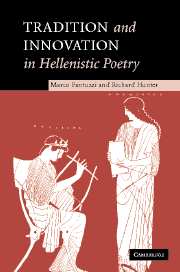Book contents
- Frontmatter
- Contents
- Preface
- List of abbreviations
- 1 Performance and genre
- 2 The aetiology of Callimachus' Aitia
- 3 The Argonautica of Apollonius and epic tradition
- 4 Theocritus and the bucolic genre
- 5 Epic in a minor key
- 6 The style of Hellenistic epic
- 7 The epigram
- 8 The languages of praise
- 9 Hellenistic drama
- 10 Roman epilogue
- Bibliography
- Index of passages discussed
- General index
4 - Theocritus and the bucolic genre
Published online by Cambridge University Press: 22 September 2009
- Frontmatter
- Contents
- Preface
- List of abbreviations
- 1 Performance and genre
- 2 The aetiology of Callimachus' Aitia
- 3 The Argonautica of Apollonius and epic tradition
- 4 Theocritus and the bucolic genre
- 5 Epic in a minor key
- 6 The style of Hellenistic epic
- 7 The epigram
- 8 The languages of praise
- 9 Hellenistic drama
- 10 Roman epilogue
- Bibliography
- Index of passages discussed
- General index
Summary
THEOCRITUS AND THE ‘REALISM’ OF EVERYDAY LIFE: IN SEARCH OF NEW WORLDS FOR POETRY
Within the panorama of Hellenistic literature, Theocritus of Syracuse reflects, as much or more than any other author of his period, the taste for polyeideia ‘writing in many literary genres’. Like his contemporary, Callimachus of Cyrene, he is a courtly encomiastic poet (Idylls 15, 16 and 17) and also a poet of ‘epyllia’ (Idylls 13, 22, 24); there is also a group of short poems in the Aeolic metre and dialect (Idylls 28–31), the last three of which are paederastic in character and clearly imitate Aeolic lyric of the archaic period, rather as Callimachus composed both Iambi, which partly recall the spirit, metre and dialect of the poetry of Hipponax, and also other poems in lyric metres, which probably reflected models drawn from archaic lyric poetry. Furthermore, Theocritus also wrote a significant number of poems with ‘realistic’ urban (Idylls 2, 14, 15) or rural (Idylls 1, 3–7, 10–11) settings, which describe scenes of daily life, for the most part in dialogue form.
It is very likely that the roots of Theocritus' description of and opposition between urban and rural environments lie in the Sicilian mime, to which, as the scholia inform us, Theocritus was indebted for two urban mimes, Idylls 2 and 15. Through the representation of typical humble characters and their daily occupations, rather than strikingly defined individuals, the Sicilian mime gave the countryside and those who lived in it a literary prominence which they had not enjoyed before.
- Type
- Chapter
- Information
- Tradition and Innovation in Hellenistic Poetry , pp. 133 - 190Publisher: Cambridge University PressPrint publication year: 2005
- 11
- Cited by



